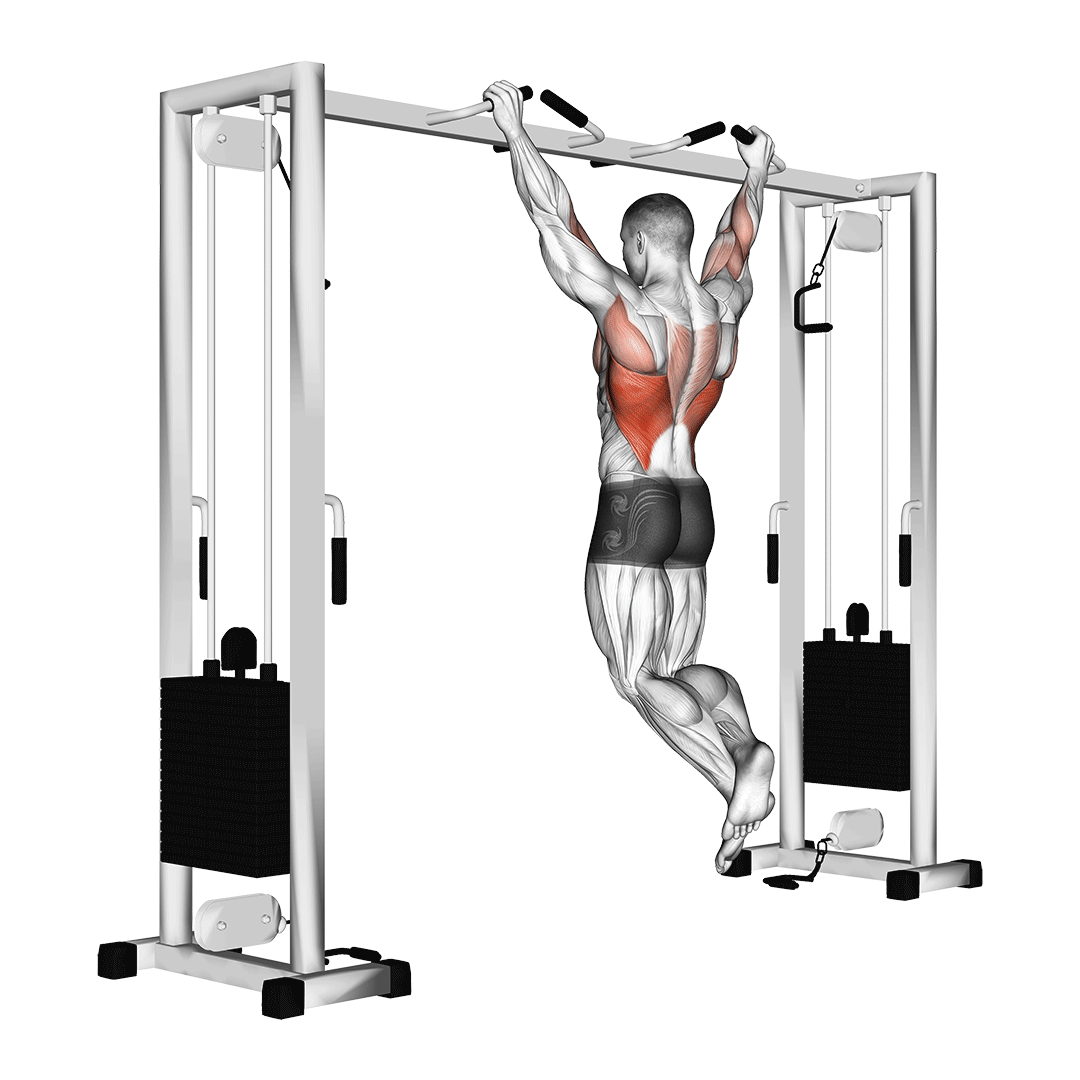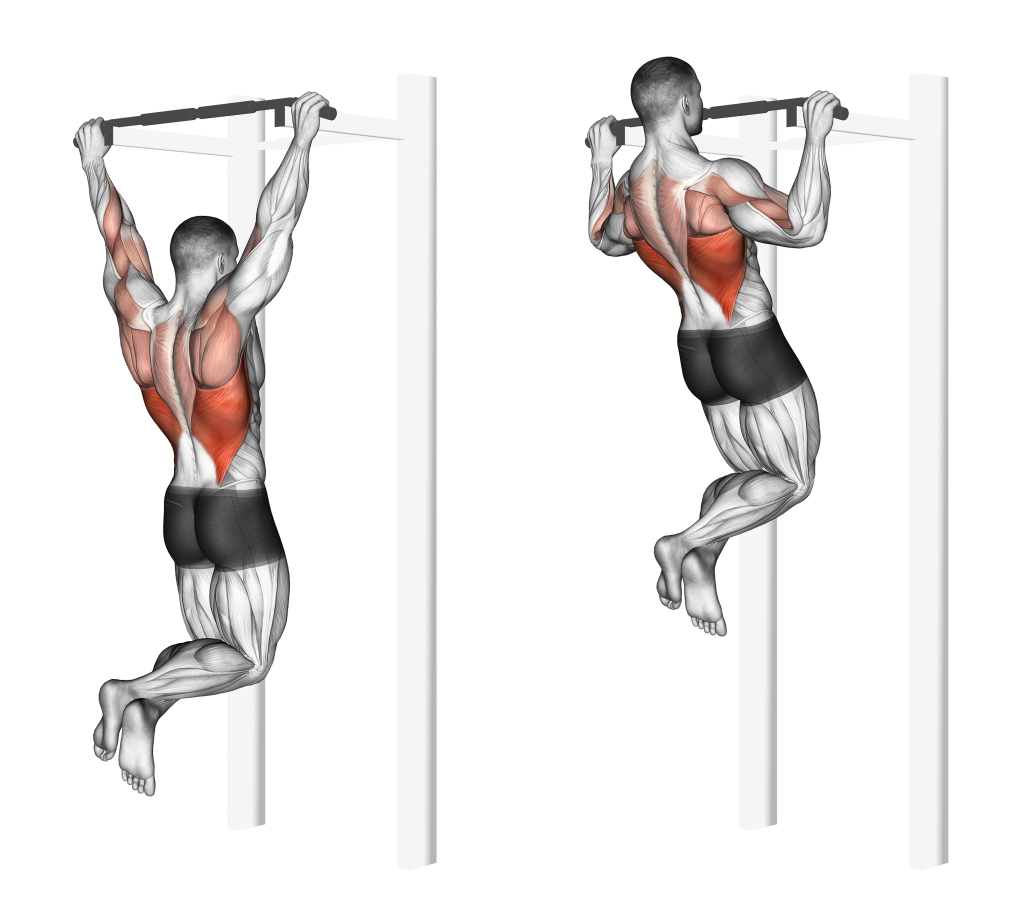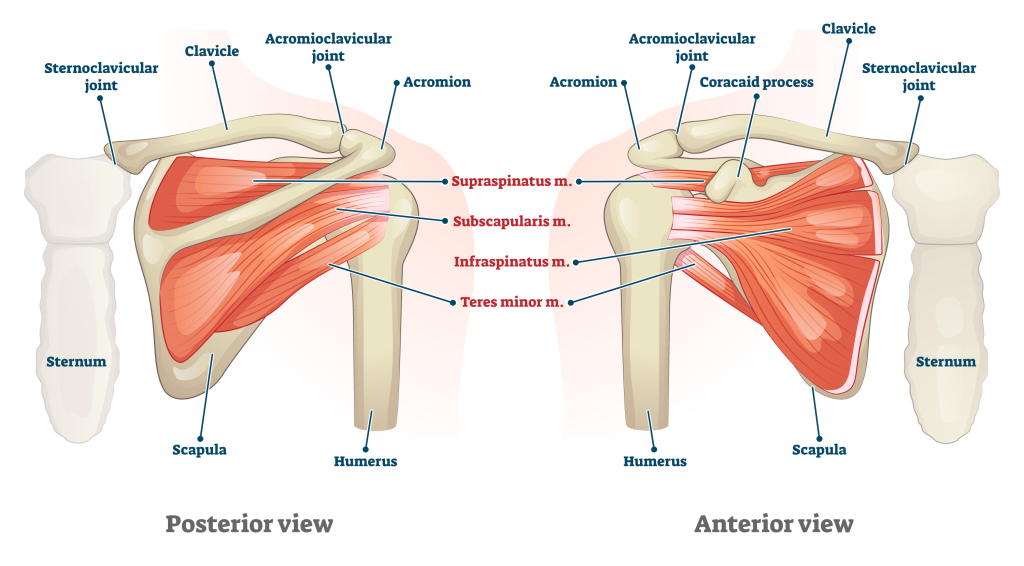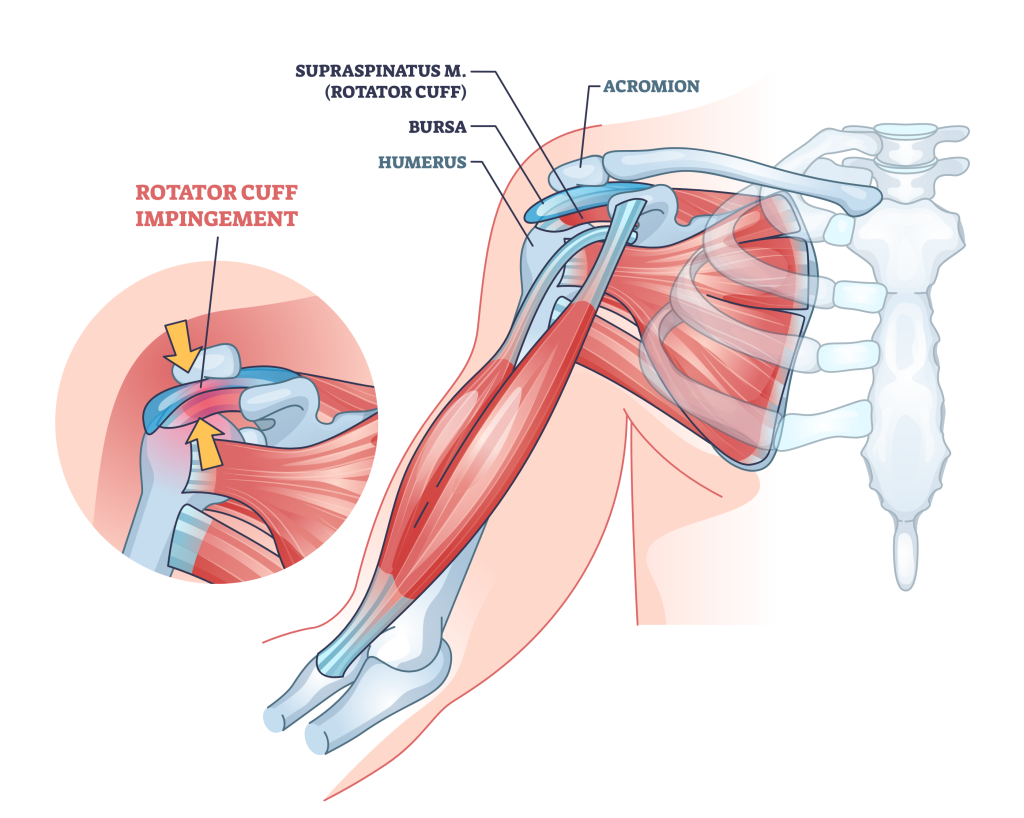Pull-Up Shoulder Pain: 5 Potential Reasons
Despite the seemingly low impact of a conventional pull-up repetition, there are quite a number of things that go wrong in regards to injury risk and symptoms of discomfort that the exerciser may experience.
One of these symptoms is pain felt in the shoulders during or after a set of pull-ups, usually of a moderate intensity and aggravated by rotating the arm within a certain range of motion.
The most likely culprit when experiencing shoulder pain from a set of pull-ups is shoulder impingement, though a number of other connective tissue-related issues like bursitis or a rotator cuff tear is also possible - all of which are most often caused by poor pull-up execution.
What is a Pull-Up?
The pull-up is a bodyweight compound resistance exercise best known for its capacity to develop muscles like the biceps brachii, latissimus dorsi and rhomboids to great effect.

While it is most often performed by calisthenic athletes or as an accessory compound movement during pull days, it can also serve as an effective warm-up tool due to its wide-spread muscular activation pattern and relatively low difficulty when performed for only a few repetitions.
How is a Pull-Up Performed?
The pull-up is performed with the exerciser beginning in a dead hang from a pull-up bar, hands in an overhand position and spread somewhat wider than shoulder-width apart.

Then, contracting the lats and bending the elbows, the exerciser will then raise themselves until the bar has passed beneath their eye-line.
Holding this position for a moment, the exerciser will then slowly lower themselves back to the original position, thereby completing the repetition.
The Shoulder Joint in Relation to Pull-Ups
The shoulder joint consists of more than just the deltoid muscles and a ball-and-socket pair, as connective tissue structures like the supraspinous tendons and muscular structures like the rotator cuff are also involved during movements with a large range of motion, much like the pull-up.

Throughout the entire movement of a pull-up repetition, the shoulder is both acting as a stabilizer for the entire body, as well as a moving joint that will rotate so as to allow the torso to move upwards and downwards as the hands remain fixed in place.
This is made possible through the rotator cuff, and is the main point of damage when pull-ups are performed incorrectly due to the rather delicate tissue it is made of.
This can be known as an impingement, as bursitis (if it is the bursa that is primarily irritated) or any other number of conditions known to affect soft tissues.
As such, diagnosing shoulder pain from a pull-up may be rather difficult without professional medical help, but can usually be reduced or prevented by correcting issues in training programming and form.
Shoulder Impingement Risk of Pull-Ups
As was previously mentioned, the most common sort of disorder caused by incorrect pull-up execution is that of the shoulder impingement; a physiological condition where the rotator cuff of the shoulder structure becomes caught beneath a bone of the scapula, usually with the accompanying lubricating bursa becoming trapped alongside it.

While not all cases of shoulder pain from pull-ups are caused by this, it is by far the most likely culprit due to the nature of how pull-ups are performed.
Unlike other shoulder injuries from the pull-up, shoulder impingement is unlikely to recover from a simple period of rest.
It is best to consult a medical professional if you suspect that you have sustained an impingement, and to otherwise cease performing any activities involving the rotator cuff.
Most Common Form Mistakes of the Pull-Up
The first area of training to investigate when experiencing shoulder pain from a set of pull-ups is that of form - even small mistakes in hand placement or a failure to properly recruit certain muscle groups that lead to an unstable and otherwise dangerous movement, resulting in injuries if left unchecked.
As always, if you are unsure of whether you are in fact performing the pull-up correctly, seeking out the advice of a professional coach who can inspect your form is the most efficient way to go about perfecting your pull-up execution.
1. Incorrect Hand Placement
The first part of pull-up execution to investigate when experiencing shoulder pain is that of the lifter’s hand placement - placing the hands too widely can cause excessive strain to be placed on the joint of the shoulder, whereas placing them too close together will cause a full breakdown in form adherence as the exerciser’s arms are placed in a disadvantageous position.
The ideal placement for the hands is only somewhat wider than the width of the lifter’s shoulders, with the hands spaced apart at equal measure and the pull-up bar gripped with an overhand grip.
2. Forward-Rotated Shoulders
At any point during the pull-up, rotating the shoulders forward can place undue stress and tension on the rotator cuff alongside other structures of the shoulder joint.
While this may seem counterintuitive to the movement of the pull-up, the shoulders are in fact meant to remain relatively parallel to the rest of the torso, with the chest avoiding any sort of collapse and the back remaining fully engaged in such a way that the shoulderblades are depressed yet still contracted.
One way of visualizing the correct position of the shoulders is that the trapezius muscles are being pulled backwards and towards the pelvis, which should aid in properly depressing the shoulder blades and thereby also keeping the shoulders themselves within the correct area.
3. Failing to Depress the Scapula
As was touched upon earlier, the scapula or shoulder blades should remain somewhat depressed throughout the movement of the pull-up, meaning that it will not ride upwards and draw itself towards the ears.
Furthermore, scapular retraction should also be partially maintained alongside this retraction, creating a pair of shoulder blades that are drawn backwards and downwards so as to keep the chest and shoulders from collapsing forward.
To achieve this, the exerciser should learn to properly contract their latissimus dorsi and master control over their scapula by performing negative pull-ups or deadhangs from the pull-up bar.
4. Poor Core, Latissimus, or Pectoral Activation
Though seemingly unrelated, poor recruitment of any of the muscles utilized during a pull-up can directly lead to shoulder pain, as a failure to properly activate muscles like the lats or pectorals can cause rounding or poor movement of the upper body.
This is also the case with poor core muscle control, as a failure to properly stabilize the movement can easily cause the shoulders to take on the role, leading to a greater risk of injury and irritation over time.
Unfortunately, there is no one way to improve conscious activation of a muscle group, as it can be caused by anything from insufficient training experience to fatigue and overtraining.
The surest way to try and maximize conscious muscular activation is to practice the pull-up in slow and controlled repetitions, all the while focusing on flexing whatever muscle group is not recruited sufficiently during ordinary training sessions.
5. Kipping or Rapid Negative Movement
Whether it is with a pull-up or not, performing any resistance exercise in an uncontrolled and excessively quick manner is a surefire way of causing injury to the more delicate parts of the body, the shoulders included.
In regards to the pull-up, this means performing a “kipping” motion or otherwise making excessive usage of momentum during either phase of the movement pattern can easily place a significant level of torsion on the shoulder joint.
To avoid this, “counting” during the apex of the repetition and otherwise performing the pull-up in a slow and controlled manner should help avoid any excessive usage of momentum, whether intentional or not.
Non-Execution Related Causes of Shoulder Pain From Pull-Ups
While the manner in which pull-ups are performed is the most likely cause of shoulder pain, several other factors relatively unrelated to actual form adherence may also cause symptoms of discomfort.
Unfortunately, unlike form issues, the following problems are somewhat more difficult to correct, and may take a length of time before any improvement is actually seen.
Lack of Warm-Up
Regardless of the intensity of the workout, exercisers should always perform a warm-up routine prior to beginning any actual working sets, as failing to do so will not only lead to an increased risk of injury but also poor athletic performance.
While this may be difficult for pull-ups, performing low-volume sets of exercises like the reverse bodyweight row or the lat pulldown should target much the same muscle groups as would be used for the pull-up.
Insufficient Shoulder Mobility
One possible cause of shoulder pain during or after a set of pull-ups has to do with the tissues of the shoulder itself - poor mobility as a result of neglect or previous injuries can easily cause pain, instability and a number of other training-affecting symptoms that should be addressed as soon as possible.
Allowing poor mobility of any joint - especially the shoulders - to remain as you perform resistance exercise will eventually lead to more severe injuries occurring, with symptoms of pain being only the beginning of such effects.
Fortunately, correcting poor mobility is rather easy, and only requires the exerciser to perform a dynamic mobility drill prior to performing pull-ups.
Including shoulder rotations, behind-the-back elbow extensions and cross-chest shoulder stretches into your mobility routine should be sufficient enough mobility work to reduce any incidence of pain due to poor mobility.
Excessive Volume and Frequency
Otherwise known as overtraining or overexertion, performing pull-ups to excess or far too frequently within a training block can lead to the irritation of various tissues across the body.
Considering the fact that the shoulders are involved in nearly every upper-body exercise, it is no surprise that they will be the first to be affected by such a level of training intensity.
Diagnosing shoulder pain due to excessive volume or excessive training frequency can be difficult, as exercisers of different demographics and training levels will be able to handle differing levels of intensity.
However, a good rule of thumb is that novice or intermediate level exercisers should generally stick to only performing pull-ups between 2 and 3 times a week, and that they should avoid training to absolute muscular exhaustion every single set.
It becomes more difficult to diagnose excessive volume and frequency for more advanced lifters, and as such more experienced athletes should seek out the advice of a lifting coach who may modify their training program so as to reduce the risk of overtraining.
When to See a Doctor for Pull-Up Shoulder Pain
In the event that your shoulder pain is accompanied by other symptoms like numbness, tingling, a loss of range of motion of the shoulder joint or discoloration of the afflicted area, it may be time to seek out a medical professional’s advice.
While it is unlikely that you have incurred a serious injury from performing pull-ups, the pain may worsen or lead to other concurrent injuries developing if it is left untreated.
Frequently Asked Questions (FAQ)
Can Pull-Ups Cause Shoulder Impingement?
Yes - in fact, pull-ups are among the most likely causes of shoulder impingement within a resistance-trained population.
Overhead arm movements that place rotational or vertical compression on the shoulder joint and surrounding bone structures can easily lead to shoulder impingement, and as such it is important to ensure that you are always performing pull-ups with correct form so as to avoid injuries like impingements.
Can Pull-Ups Hurt Your Rotator Cuff?
Yes - pull-ups performed to excess or with improper form can damage the rotator cuff, potentially leading to issues like tears in the soft tissue or irritation that can present as pain and an acute loss of mobility.
To avoid this, it is important to ensure that you are following a sound training program, and that every repetition of the pull-up is performed with full adherence to form cues.
How do I Know if I Have Damaged My Rotator Cuff?
Unfortunately, it can be difficult to ascertain whether you have damaged your rotator cuff or sustained a different injury due to the rather similar symptoms between all soft tissue injuries.
For the most part, a damaged or irritated rotator cuff will feel tender and sharply painful, and may be accompanied by other symptoms like numbness, tingling, discoloration or an acute loss of shoulder mobility, especially when rotating the arms overhead.
In Conclusion
Whether you believe that the pain is due to an injury you’ve sustained, or simply a consequence of some other aspect of your training methods being poorly optimized - it is a good idea to ask a coach or physician to take a look at the cause of your symptoms.
In meantime, ensure that you are allowing the affected shoulder to rest, and that you are taking all steps possible to reduce any worsening of your injury.
References
1. Urbanczyk CA, Prinold JAI, Reilly P, Bull AMJ. Avoiding high-risk rotator cuff loading: Muscle force during three pull-up techniques. Scand J Med Sci Sports. 2020 Nov;30(11):2205-2214. doi: 10.1111/sms.13780. Epub 2020 Aug 7. PMID: 32715526.
2. Prinold JA, Bull AM. Scapula kinematics of pull-up techniques: Avoiding impingement risk with training changes. J Sci Med Sport. 2016 Aug;19(8):629-35. doi: 10.1016/j.jsams.2015.08.002. Epub 2015 Sep 3. PMID: 26383875; PMCID: PMC4916995.
